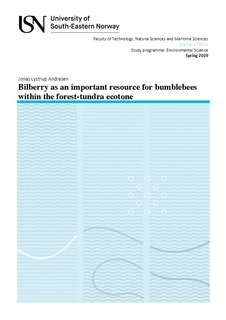| dc.description.abstract | Bumblebees are important pollinators for many plant species in high altitude environments. However, bumblebee populations currently show trends of decline as a result of several interacting drivers. Among these drivers, climate change is considered important. Global warming can cause rapid environmental changes particularly at high altitudes and has led to upslope shifts of lowaltitude bumblebee species. The forest-tundra ecotone is constituted by heterogenous environments, which contain potential habitats for both low-altitude bumblebee species and bumblebee species adapted to high-altitude conditions. In spring, when floral richness is low within the ecotone, Vaccinium myrtillus offers large floral resources for early-emerging bumblebees. Over the course of the V. myrtillus flowering season, I examined how bumblebee abundance and species richness within the forest-tundra ecotone were affected by climatic factors and floral resource abundance in V. myrtillus communities. I additionally implemented DNA metabarcoding analysis of corbicular pollen loads from foraging bumblebees. Results from the barcoding analyses, together with observed flower visits, were then used to reveal species-specific floral preferences and temporal changes in the structure of plant-bumblebee interactions. I found that pollen compositions of the collected pollen loads largely reflected observed flower visits, suggesting that V. myrtillus communities provided valuable resources. I additionally found that bumblebee abundance and species richness was positively affected by local temperatures. Higher abundances of foraging bumblebees were recorded at intermediate altitude in the low alpine zone. The results also indicate that plant-bumblebee interactions were mutualistic, given the high dominance of bumblebees as visitors to V. myrtillus. While bumblebee pollen diets consisted of mainly V. myrtillus in spring, they were supplemented by other floral resources. Pollen diets in summer consisted of mainly M. pratense. Plant-bumblebee interactions formed generalized network structures, but the degree of specialization increased with seasonality, indicating that bumblebees narrowed their niche breadth as more flowers became available. In light of declining bumblebee populations in a changing climate, this study provide further evidence that bumblebees find valuable resources in V. myrtillus communities. The mutualistic plant-bumblebee interactions may further accelerate the upslope shifts of both V. myrtillus communities and generalist bumblebee species. | nb_NO |
